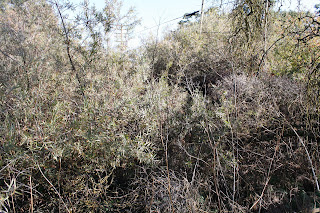
We journeyed into the hills above the Jerusalem Grade in the southern part of the county. Our objective: to see the 160 acre property being put up for sale by Bay Area journalist/editor couple Lyle and Matt. This upland ranch is a serene place of grassy swales rising into blue oak savannah and chaparral. A pair of bluebirds hawked for insects. A covey of California quail, airborne, glided across a sunken meadow. The elevation, soil and topography of the land make for a striking contrast from the relatively lush and deep-soiled floor of Big Valley. Here the plant communities are in a climax state of equilibrium, undisturbed, except by wild fire, for human generations. This is not an area which promised much to settler farmers. Instead it served as range for cattle and sheep. We saw coyote, gray fox and possibly bobcat scat on the trails. It is the sort of relatively undisturbed Coast Range landscape in which most of the pieces of the native mosaic are still present.

Where a bulldozer had scraped a fire break through the chaparral, Lake County diamonds lay exposed on the eroded red dirt.
A product, like obsidian, of the region's vulcan upheavals, the diamonds are actually beta silicon dioxide crystals. Lava flows of magma and basalt from Mount Konocti where contained under enormous pressure with temperatures of at least 1,112 degrees Fahrenheit, producing the diamonds.

Back in Big Valley it is a bumper year for walnuts and acorns. Last year there were none in either category. Elaine lent her drying screen.

The valley oaks were backlit by late afternoon sunlight.

Sweet gum, slash pile, and Mount Konocti. Golden-crowned and white-crowned sparrows, having just arrived from the north, shelter in the caverns of the slash pile.

It is a time of year when unexpected species come to the fountain, in this case a red-bellied sapsucker. The first group of migrating yellow-rumped warblers also arrived.

Ed has been busy stocking the cellar with the abundance of the harvest.

Eames chairs in the studio.


















































